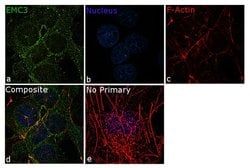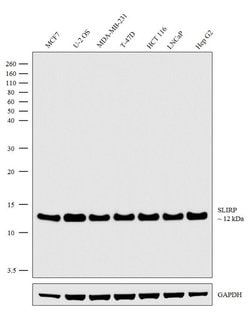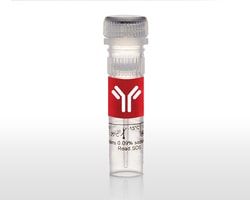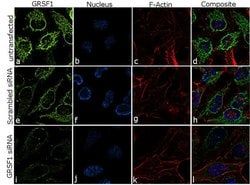70-274-4
ING2 Recombinant Rabbit Monoclonal Antibody (2H44L53), Invitrogen™
Manufacturer: Invitrogen
Select a Size
| Pack Size | SKU | Availability | Price |
|---|---|---|---|
| Each | 70-274-4-Each | In Stock | ₹ 36,369.85 |
70-274-4 - Each
In Stock
Quantity
1
Base Price: ₹ 36,369.85
GST (18%): ₹ 6,546.573
Total Price: ₹ 42,916.423
Antigen
ING2
Classification
Monoclonal
Concentration
0.5 mg/mL
Formulation
PBS with 0.09% sodium azide; pH 7.4
Gene Accession No.
Q9ESK4, Q9H160
Gene Symbols
Ing2
Immunogen
Protein corresponding to human ING2 [aa1-aa280]
Quantity
100 μg
Primary or Secondary
Primary
Target Species
Human, Mouse
Product Type
Antibody
Isotype
IgG
Applications
ChIP Assay, Western Blot
Clone
2H44L53
Conjugate
Unconjugated
Gene
Ing2
Gene Alias
2810011M06Rik; ING1L; ING1Lp; ING2; Ing2b; Inhibitor of growth 1-like protein; inhibitor of growth family member 2; inhibitor of growth family, member 2; inhibitor of growth protein 2; p32; p33ING2
Host Species
Rabbit
Purification Method
Protein A
Regulatory Status
RUO
Gene ID (Entrez)
3622, 69260
Content And Storage
Store at 4°C short term. For long term storage, store at -20°C, avoiding freeze/thaw cycles.
Form
Liquid
Related Products
Description
- This antibody is predicted to react with Monkey, Pig, Cat
- Recombinant rabbit monoclonal antibodies are produced using in vitro expression systems
- The expression systems are developed by cloning in the specific antibody DNA sequences from immunoreactive rabbits
- Then, individual clones are screened to select the best candidates for production
- The advantages of using recombinant rabbit monoclonal antibodies include: better specificity and sensitivity, lot-to-lot consistency, animal origin-free formulations, and broader immunoreactivity to diverse targets due to larger rabbit immune repertoire
- This gene is a member of the inhibitor of growth (ING) family
- Members of the ING family associate with and modulate the activity of histone acetyltransferase (HAT) and histone deacetylase (HDAC) complexes and function in DNA repair and apoptosis.
Compare Similar Items
Show Difference
Antigen: ING2
Classification: Monoclonal
Concentration: 0.5 mg/mL
Formulation: PBS with 0.09% sodium azide; pH 7.4
Gene Accession No.: Q9ESK4, Q9H160
Gene Symbols: Ing2
Immunogen: Protein corresponding to human ING2 [aa1-aa280]
Quantity: 100 μg
Primary or Secondary: Primary
Target Species: Human, Mouse
Product Type: Antibody
Isotype: IgG
Applications: ChIP Assay, Western Blot
Clone: 2H44L53
Conjugate: Unconjugated
Gene: Ing2
Gene Alias: 2810011M06Rik; ING1L; ING1Lp; ING2; Ing2b; Inhibitor of growth 1-like protein; inhibitor of growth family member 2; inhibitor of growth family, member 2; inhibitor of growth protein 2; p32; p33ING2
Host Species: Rabbit
Purification Method: Protein A
Regulatory Status: RUO
Gene ID (Entrez): 3622, 69260
Content And Storage: Store at 4°C short term. For long term storage, store at -20°C, avoiding freeze/thaw cycles.
Form: Liquid
Antigen:
ING2
Classification:
Monoclonal
Concentration:
0.5 mg/mL
Formulation:
PBS with 0.09% sodium azide; pH 7.4
Gene Accession No.:
Q9ESK4, Q9H160
Gene Symbols:
Ing2
Immunogen:
Protein corresponding to human ING2 [aa1-aa280]
Quantity:
100 μg
Primary or Secondary:
Primary
Target Species:
Human, Mouse
Product Type:
Antibody
Isotype:
IgG
Applications:
ChIP Assay, Western Blot
Clone:
2H44L53
Conjugate:
Unconjugated
Gene:
Ing2
Gene Alias:
2810011M06Rik; ING1L; ING1Lp; ING2; Ing2b; Inhibitor of growth 1-like protein; inhibitor of growth family member 2; inhibitor of growth family, member 2; inhibitor of growth protein 2; p32; p33ING2
Host Species:
Rabbit
Purification Method:
Protein A
Regulatory Status:
RUO
Gene ID (Entrez):
3622, 69260
Content And Storage:
Store at 4°C short term. For long term storage, store at -20°C, avoiding freeze/thaw cycles.
Form:
Liquid
Antigen: PCK2
Classification: Recombinant Monoclonal
Concentration: 0.5 mg/mL
Formulation: PBS with 0.09% sodium azide; pH 7.4
Gene Accession No.: Q16822
Gene Symbols: PCK2
Immunogen: Peptides corresponding to human PEPCK [1) aa621-aa637 2) aa395-aa414]
Quantity: 100μg
Primary or Secondary: Primary
Target Species: Human
Product Type: Antibody
Isotype: IgG
Applications: Immunocytochemistry, Western Blot
Clone: 16H5L22
Conjugate: Unconjugated
Gene: PCK2
Gene Alias: 1810010O14Rik; 9130022B02Rik; HGNC:8725; PCK2; PEP carboxykinase; PEPCK; PEPCK2; PEPCK-M; Phosphoenolpyruvate carboxykinase [GTP], mitochondrial; phosphoenolpyruvate carboxykinase 2 (mitochondrial); phosphoenolpyruvate carboxykinase 2, mitochondrial; phosphoenolpyruvate carboxylase; phosphopyruvate carboxylase
Host Species: Rabbit
Purification Method: Protein A
Regulatory Status: RUO
Gene ID (Entrez): 5106
Content And Storage: Store at 4°C short term. For long term storage, store at -20°C, avoiding freeze/thaw cycles.
Form: Liquid
Antigen:
PCK2
Classification:
Recombinant Monoclonal
Concentration:
0.5 mg/mL
Formulation:
PBS with 0.09% sodium azide; pH 7.4
Gene Accession No.:
Q16822
Gene Symbols:
PCK2
Immunogen:
Peptides corresponding to human PEPCK [1) aa621-aa637 2) aa395-aa414]
Quantity:
100μg
Primary or Secondary:
Primary
Target Species:
Human
Product Type:
Antibody
Isotype:
IgG
Applications:
Immunocytochemistry, Western Blot
Clone:
16H5L22
Conjugate:
Unconjugated
Gene:
PCK2
Gene Alias:
1810010O14Rik; 9130022B02Rik; HGNC:8725; PCK2; PEP carboxykinase; PEPCK; PEPCK2; PEPCK-M; Phosphoenolpyruvate carboxykinase [GTP], mitochondrial; phosphoenolpyruvate carboxykinase 2 (mitochondrial); phosphoenolpyruvate carboxykinase 2, mitochondrial; phosphoenolpyruvate carboxylase; phosphopyruvate carboxylase
Host Species:
Rabbit
Purification Method:
Protein A
Regulatory Status:
RUO
Gene ID (Entrez):
5106
Content And Storage:
Store at 4°C short term. For long term storage, store at -20°C, avoiding freeze/thaw cycles.
Form:
Liquid
Antigen: __
Classification: __
Concentration: __
Formulation: __
Gene Accession No.: __
Gene Symbols: __
Immunogen: __
Quantity: 5 mg
Primary or Secondary: __
Target Species: __
Product Type: __
Isotype: __
Applications: __
Clone: __
Conjugate: __
Gene: __
Gene Alias: __
Host Species: __
Purification Method: __
Regulatory Status: __
Gene ID (Entrez): __
Content And Storage: __
Form: __
Antigen:
__
Classification:
__
Concentration:
__
Formulation:
__
Gene Accession No.:
__
Gene Symbols:
__
Immunogen:
__
Quantity:
5 mg
Primary or Secondary:
__
Target Species:
__
Product Type:
__
Isotype:
__
Applications:
__
Clone:
__
Conjugate:
__
Gene:
__
Gene Alias:
__
Host Species:
__
Purification Method:
__
Regulatory Status:
__
Gene ID (Entrez):
__
Content And Storage:
__
Form:
__
Antigen: Optineurin
Classification: Monoclonal
Concentration: 0.5 mg/mL
Formulation: PBS with 0.09% sodium azide; pH 7.4
Gene Accession No.: Q8K3K8, Q8R5M4, Q96CV9
Gene Symbols: OPTN
Immunogen: Peptides corresponding to human Optineurin [1) aa171-aa186, 2) aa27-aa42]
Quantity: 100 μg
Primary or Secondary: Primary
Target Species: Human, Mouse, Rat
Product Type: Antibody
Isotype: IgG
Applications: Immunocytochemistry, Western Blot
Clone: 22H12L20
Conjugate: Unconjugated
Gene: OPTN
Gene Alias: 14.7K-interacting protein 2; 4930441O07Rik; Ag9 C5; ALS12; E3-14.7K-interacting protein; FIP 2; FIP2; FIP-2; FIP-2-like protein; GLC1E; HIP 7; HIP7; HIP-7; Huntingtin interacting protein L; huntingtin yeast partner L; Huntingtin-interacting protein 7; huntingtin-interacting protein L; HYPL; NEMO-related protein; NRP; Optic neuropathy-inducing protein; optineurin; Optn; TFIIIA IntP; TFIIIA-IntP; transcription factor IIIA-interacting protein; transcrption factor IIIA-interacting protein; tumor necrosis factor alpha-inducible cellular protein containing leucine zipper domains; Uban
Host Species: Rabbit
Purification Method: Protein A
Regulatory Status: RUO
Gene ID (Entrez): 10133, 246294, 71648
Content And Storage: Store at 4°C short term. For long term storage, store at -20°C, avoiding freeze/thaw cycles.
Form: Liquid
Antigen:
Optineurin
Classification:
Monoclonal
Concentration:
0.5 mg/mL
Formulation:
PBS with 0.09% sodium azide; pH 7.4
Gene Accession No.:
Q8K3K8, Q8R5M4, Q96CV9
Gene Symbols:
OPTN
Immunogen:
Peptides corresponding to human Optineurin [1) aa171-aa186, 2) aa27-aa42]
Quantity:
100 μg
Primary or Secondary:
Primary
Target Species:
Human, Mouse, Rat
Product Type:
Antibody
Isotype:
IgG
Applications:
Immunocytochemistry, Western Blot
Clone:
22H12L20
Conjugate:
Unconjugated
Gene:
OPTN
Gene Alias:
14.7K-interacting protein 2; 4930441O07Rik; Ag9 C5; ALS12; E3-14.7K-interacting protein; FIP 2; FIP2; FIP-2; FIP-2-like protein; GLC1E; HIP 7; HIP7; HIP-7; Huntingtin interacting protein L; huntingtin yeast partner L; Huntingtin-interacting protein 7; huntingtin-interacting protein L; HYPL; NEMO-related protein; NRP; Optic neuropathy-inducing protein; optineurin; Optn; TFIIIA IntP; TFIIIA-IntP; transcription factor IIIA-interacting protein; transcrption factor IIIA-interacting protein; tumor necrosis factor alpha-inducible cellular protein containing leucine zipper domains; Uban
Host Species:
Rabbit
Purification Method:
Protein A
Regulatory Status:
RUO
Gene ID (Entrez):
10133, 246294, 71648
Content And Storage:
Store at 4°C short term. For long term storage, store at -20°C, avoiding freeze/thaw cycles.
Form:
Liquid











